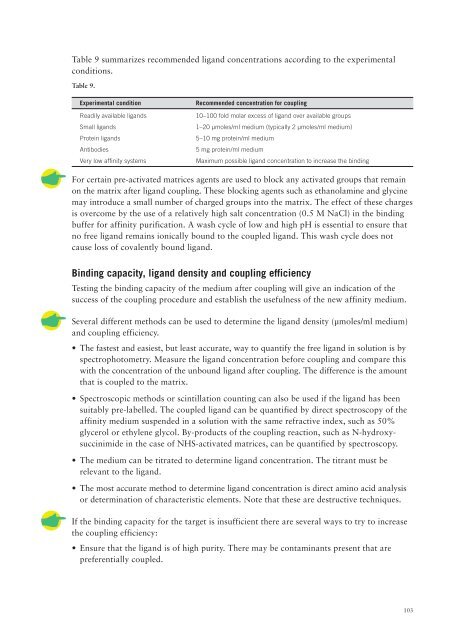Affinity Chromatography - Department of Molecular and Cellular ...
Affinity Chromatography - Department of Molecular and Cellular ...
Affinity Chromatography - Department of Molecular and Cellular ...
Create successful ePaper yourself
Turn your PDF publications into a flip-book with our unique Google optimized e-Paper software.
Table 9 summarizes recommended lig<strong>and</strong> concentrations according to the experimental<br />
conditions.<br />
Table 9.<br />
Experimental condition<br />
Readily available lig<strong>and</strong>s<br />
Small lig<strong>and</strong>s<br />
Protein lig<strong>and</strong>s<br />
Antibodies<br />
Very low affinity systems<br />
Recommended concentration for coupling<br />
10–100 fold molar excess <strong>of</strong> lig<strong>and</strong> over available groups<br />
1–20 µmoles/ml medium (typically 2 µmoles/ml medium)<br />
5–10 mg protein/ml medium<br />
5 mg protein/ml medium<br />
Maximum possible lig<strong>and</strong> concentration to increase the binding<br />
For certain pre-activated matrices agents are used to block any activated groups that remain<br />
on the matrix after lig<strong>and</strong> coupling. These blocking agents such as ethanolamine <strong>and</strong> glycine<br />
may introduce a small number <strong>of</strong> charged groups into the matrix. The effect <strong>of</strong> these charges<br />
is overcome by the use <strong>of</strong> a relatively high salt concentration (0.5 M NaCl) in the binding<br />
buffer for affinity purification. A wash cycle <strong>of</strong> low <strong>and</strong> high pH is essential to ensure that<br />
no free lig<strong>and</strong> remains ionically bound to the coupled lig<strong>and</strong>. This wash cycle does not<br />
cause loss <strong>of</strong> covalently bound lig<strong>and</strong>.<br />
Binding capacity, lig<strong>and</strong> density <strong>and</strong> coupling efficiency<br />
Testing the binding capacity <strong>of</strong> the medium after coupling will give an indication <strong>of</strong> the<br />
success <strong>of</strong> the coupling procedure <strong>and</strong> establish the usefulness <strong>of</strong> the new affinity medium.<br />
Several different methods can be used to determine the lig<strong>and</strong> density (µmoles/ml medium)<br />
<strong>and</strong> coupling efficiency.<br />
• The fastest <strong>and</strong> easiest, but least accurate, way to quantify the free lig<strong>and</strong> in solution is by<br />
spectrophotometry. Measure the lig<strong>and</strong> concentration before coupling <strong>and</strong> compare this<br />
with the concentration <strong>of</strong> the unbound lig<strong>and</strong> after coupling. The difference is the amount<br />
that is coupled to the matrix.<br />
• Spectroscopic methods or scintillation counting can also be used if the lig<strong>and</strong> has been<br />
suitably pre-labelled. The coupled lig<strong>and</strong> can be quantified by direct spectroscopy <strong>of</strong> the<br />
affinity medium suspended in a solution with the same refractive index, such as 50%<br />
glycerol or ethylene glycol. By-products <strong>of</strong> the coupling reaction, such as N-hydroxysuccinimide<br />
in the case <strong>of</strong> NHS-activated matrices, can be quantified by spectroscopy.<br />
• The medium can be titrated to determine lig<strong>and</strong> concentration. The titrant must be<br />
relevant to the lig<strong>and</strong>.<br />
• The most accurate method to determine lig<strong>and</strong> concentration is direct amino acid analysis<br />
or determination <strong>of</strong> characteristic elements. Note that these are destructive techniques.<br />
If the binding capacity for the target is insufficient there are several ways to try to increase<br />
the coupling efficiency:<br />
• Ensure that the lig<strong>and</strong> is <strong>of</strong> high purity. There may be contaminants present that are<br />
preferentially coupled.<br />
103
















